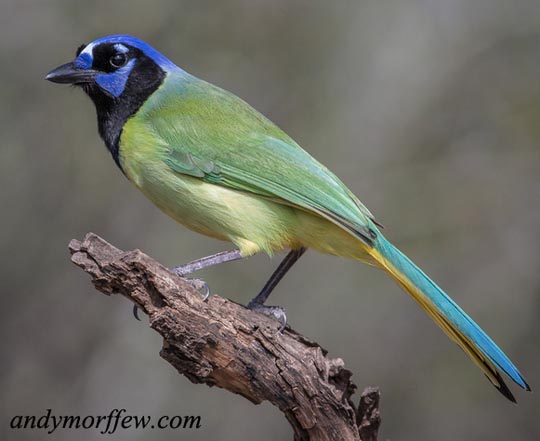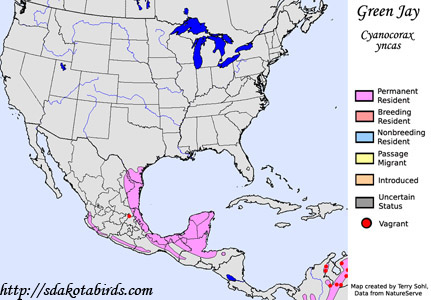| Length: 10.5 inches | Wingspan: 13.5 inches | Seasonality: Non-resident in South Dakota |
| ID Keys: Pale green overall, blue head, black neck and facial features | ||
 The
Green Jay is an unmistakable species that is relatively common in Mexico and
elsewhere in Latin America, but was unknown in the United States until they
started appearing in southern Texas in the 1970s. They are still only
found in the far southern part of Texas, but their range and numbers appear
to be expanding in recent decades. There is some debate as to whether
there should actually be two different species of Green Jay.
Populations in the U.S., Mexico, and Central America are geographically
separated from populations found in South America, and there are also
differences in plumage and habits.
The
Green Jay is an unmistakable species that is relatively common in Mexico and
elsewhere in Latin America, but was unknown in the United States until they
started appearing in southern Texas in the 1970s. They are still only
found in the far southern part of Texas, but their range and numbers appear
to be expanding in recent decades. There is some debate as to whether
there should actually be two different species of Green Jay.
Populations in the U.S., Mexico, and Central America are geographically
separated from populations found in South America, and there are also
differences in plumage and habits.
Habitat: Green Jays in the United States are most often found in dense forests along the Rio Grande river. In the rest of their range, they can be found in a variety of woodland habitats, typically in more open woodlands or along woodland edges and clearings.
Diet: Omnivorous, feeding on a wide variety of items, including insects and spiders, small lizards, snakes, and amphibians, small rodents, bird eggs and young nestlings, fruits, berries, nuts, and sometimes human refuse.
Behavior: Green Jays are often gregarious, foraging in flocks. They will use a variety of foraging techniques, depending upon locality and what food items are available. Very opportunistic.
Nesting: Green Jays have rather complicating nesting and breeding patterns. Typically, for birds in the U.S., a small breeding colony has one nest with one breeding pair of birds. The previous year's brood stays with the breeding parents and helps to defend the territory and raise the young. Nest building itself is also often communal, with multiple members of the flock helping to construct the nest, a crudely built cup of sticks, twigs, leaves, and soft plant material.
Song: Variable series of calls, often harsh croaking or other shrill calls.
Migration: Non-migratory, considered a permanent resident throughout their range.
Interactive eBird Map: Click here to access an interactive eBird map of Green Jay sightings
Feeders: Green Jays will occasionally use feeders stocked with fruit, nuts, and some human table food.
Similar Species: Unlikely to be confused with other bird species
Conservation Status: There are no major conservation concerns at this time. The IUCN lists the Green Jay as a species of "Least Concern".
Further Information: 1) Auudbon Guide - Green Jay
2) U.S. Geological Survey's Bird InfoCenter- Green Jay
3) WhatBird - Green Jay
Image Information: Photo by Andy Morffew - Photo licensed under Creative Commons Attribution NoDerivs 2.0 Generic license.
| Click below for a higher-resolution map |
 |
| South Dakota Status: Non-resident in South Dakota |
Additional Green Jay Photos (coming soon!!)
